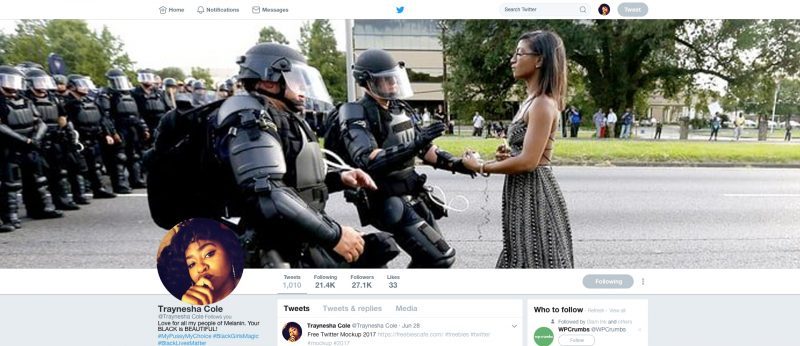How to protect both yourself and the people around you in the age of information manipulation
Like many people, you may know that Russia “meddled” in the 2016 election, but you may not know how. You may have a vague idea that companies like Cambridge Analytica were stealing data, but you may not know how that affects you. And finally, you may have a sneaking suspicion that it’s still happening, but you don’t know what you can really do about it.
Here is a quick primer on what to look for, what it means, and how to avoid entangling yourself and those around you in further attempts to manipulate you.
Step 1: How to spot attempts to manipulate you or others.
The first thing you have to know is that the goal of most of these attempts is not to try and convince you of something. Rather, it’s to confuse you, make you unsure, make you question, and often, to make you become angry, frustrated or just give up and disengage.
According to the Alliance for Securing Democracy, an organization founded to track and report on Russian disinformation campaigns, Russians engaged in all of the following during the 2016 election: “1) using fake personas, websites, and automation to flood the information zone; 2) manipulating search results; 3) recruiting Americans to take action offline and using traditional media to spread manipulated content; 4) amplifying extreme content to increase polarization; 5) undermining faith in institutions, including the integrity of elections; 6) influencing public opinion directly, both in the U.S. and globally, in ways directly at odds with U.S. interests; and 7) spreading hacked and weaponized information.” (Source)
FAKE OR MANIPULATED INFORMATION: This information is meant to muddy the waters, make facts unclear, make controversial issues seem more volatile or overly simplistic, or sway public conversation away from more pressing news that day. Methods include “news” articles that looks legitimate, but actually comes from a questionable source with no editorial oversight. Faked videos like the “deepfake” video below–this technology is improving by leaps and bounds every day. And claims in comment sections, social media, etc. that refer to half-truths, misrepresentations, outright lies or truths without context are common.
FAKE PERSONAS/BOTS: These often look like real people, but they’re not. They are part of a network of accounts used for various purposes–most often to start the spread of misinformation and make it look more popular or legitimate than it really is. Below are a few mock-up bot accounts similar to ones used in the 2016 elections that were banned from Twitter. They often have many followers and tons of activity because they are linked to a network of other bot accounts that boost each other’s numbers and content.



FAKE WEBSITES: These are often made to look like real organizations, campaigns or groups to confuse people or, worse, to collect information or donations for future targeting purposes. This is a screenshot of an actual website that’s live right now that was created by a Republican-backed consultant linked to the Trump campaign. (I’m not sharing the link to the actual fake site because traffic can help boost a website’s rating in search algorithms. Don’t visit the site.)

FAKE FACEBOOK GROUPS: These groups may look like something you’re interested in, but they are often filled with bot accounts and extreme discussions designed to get you, a real person, to share the same information they are sharing in the group with your personal contacts. Often these groups “keyword squat” to gain members. They change the group name to look like something you are more likely to be searching for and gain lots of new real members that way. Here’s an example of a group keyword squatting after Stephen Hawking passed away. This same group had a name related to the March for Our Lives before changing it to RIP STEPHEN HAWKING 2018 and it’s been heavily associated with the spread of misinformation campaigns.

Step 2: How to avoid being targeted.
You may be tempted to engage with information that you find incredibly interesting or incredibly offensive on the internet, but be warned–even the most benign post or forwarded email can be an attempt to gather information from you for future use. And knowing what you’re against can be just as valuable as knowing what you are for.
Want to hear something creepy? Almost everything you are doing online nowadays can be tracked pretty easily.
- We at the Canyon Dems know when you read the emails we send you and we know what links you click on in them–and most other organizations and companies do, too.
- If you are browsing the internet while you’re logged into Facebook, Facebook can log that information through Facebook Pixel for companies or organizations to market to you later inside Facebook.
- Most websites have a way of setting tracking cookies on your browser to grab information about you and what you’re looking at.
- Your phone does amazing things, but it can also make it possible to track your location, share your contacts with third parties and even make it more likely for your face to wind up in facial recognition trackers–yay, selfies!
Things you can do right now to help turn off the flood of information you are sharing about yourself.
- Turn off location services, or limit its use severely to just apps that should have access to your location (like a maps app, and only when it’s open).
- Android: https://support.google.com/accounts/answer/3467281?hl=en
- Apple: https://support.apple.com/en-us/HT207092
- Facebook: Settings→ Location→ Turn it off
- Turn off facial recognition services
- Facebook: Settings→ Face Recognition→ Turn it off
- Facebook: Settings→ Face Recognition→ Turn it off
- Turn off information you’ve previously agreed to share
- Facebook: Settings→ Apps & Websites as well as Instant Games → Remove any organizations you no longer want to share info with
- Internet Browsers: https://community.trimble.com/docs/DOC-10001-how-to-disable-plugins-add-ons-and-extensions-in-multiple-browsers
- Delete tracking information Facebook is using to target you.
- Facebook: Settings→ Ads→ “X” things off your lists and turn off settings you don’t want shared
- Facebook: Settings→ Ads→ “X” things off your lists and turn off settings you don’t want shared
- Create an extra email address you only use as a “dummy” account. When something you want to participate in requires an email address you’d rather not share, give them this extra email address instead. Your email address is connected to your online persona in many ways. If someone can get your email address, they can often connect it to your social media accounts, LinkedIn account, employer, etc. Sharing the one you use for more personal correspondence or banking or employment, can give someone the opportunity to link you with other information they may have already in another profile.
- Stop giving people or organizations you don’t know free info about yourself.
- Polls: Do you know the company you’re talking to or did they just call you out of the blue? One thing we know from the Mueller’s report is that Paul Manafort, Trump’s campaign manager, shared 2016 internal polling data from battleground states with a Russian-linked contact. If that doesn’t make you want to keep things to yourself, I don’t know what will.
- Online Quizzes or Questionairres: That app on Facebook looks pretty fun–I mean it’ll tell you what Disney Princess you’d be or what vacation spot most closely matches your interests. But did you read the fine print before firing off a bunch of personal info in the responses? Most of those apps include data sharing, often along with collecting your personal information on Facebook, and that’s exactly how Cambridge Analytica got its hands on so much data–via a personality quiz app on Facebook.
Step 3: What to do when you see manipulated information–or if you aren’t sure.
This step is actually the easiest: JUST DON’T SHARE IT. As tempting as it is to click that share or forward, even if it’s just to point out how wrong it is–don’t! Just stop. You may think you are doing a public service or sharing something interesting with your closest friends, but this has three effects.
- Your friends may not “get” that you are sharing something with them in a sarcastic or negative way. Even if they do get it, they may forward it on and their friends won’t “get” it. And because it came from you, someone they know and most likely trust, they are psychologically more likely to engage with the information positively. We are naturally receptive to information shared with us from people we already have established relationships with. That’s why “going viral” is the goal of every piece of misinformation.
- Even if everyone you know understands why you are sharing it, your engagement with the material is captured in many ways. Every time you share something on Facebook, Twitter, Instagram, those numbers are seen by everyone. The “most shared” material is often filtered into “must see” lists by social media services and algorithmically bubbles to the top of recommended videos and stories. So you are inadvertently making it more likely that EVERYONE sees the material and you won’t be able to frame the context like you would be for just the folks you are sharing with.
- Your engagement may also be logged for future use in targeting you or people you know in ways that may be hard to spot!
SHARE GOOD INFO: People creating disinformation campaigns are relying on you to share their information. If you see an interesting link on a subject, take one extra step to find a similar article in a reputable, edited news source and share that instead! If you can’t find one, it means the info is probably not correct!
REPORT BAD INFO: If you see something that is obviously misinformation and it bothers you enough to do something about it–report it. Most social media platforms now give you the ability to block and report. Clicking on the three dots in the top right of any Facebook or Instagram post will give you the option to “Report Post” and select a reason you are reporting it. The down arrow in the top right of any Twitter post will give you the same option. Almost any social media or website that allows users to post content (like Pintrest, Reddit, etc.) will have a way to report users and content to be removed.
Don’t go crazy with this though, as it’s usually akin to bailing out a boat with a teaspoon. Social media sites for the most part don’t have a large vested interest in policing misinformation on their platforms. They are desperate for views, users, content and engagement as part of their business model, so they actually have an incentive to ignore bots and salacious misinformation that people love to share.
DON’T ENGAGE WITH PEOPLE OR SITES YOU DON’T KNOW: This is just a recommendation, but don’t bother engaging directly with folks you don’t know or sites you don’t know. If they are real, you’re unlikely to change their minds since you don’t really know them and they are very likely “trolling” you (think sibling poking you just to watch you get mad). And if they aren’t real, you may as well turn around and fire off a witty retort to your microwave. It will waste the same amount of time. Instead, spend your time finding real, actual people to talk to and engage with them instead.
That’s it! Remember, misinformation only does damage when you let it get to you or you share it. Let’s do the best thing we can and just ignore it.
Hopefully you have a better understanding of what to look for, how to avoid being targeted and what to do when you see misinformation out in the wild. If you’ve attended one of our meetings, you know that we are real people working very hard in our local neighborhoods to elect Democrats up and down the ticket. If you haven’t attended one of our meetings, we encourage you to come out and meet us! If you found this information useful, feel free to share it with family and friends. Better yet, give them a link to this exact article when they forward you something that they shouldn’t have!

